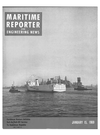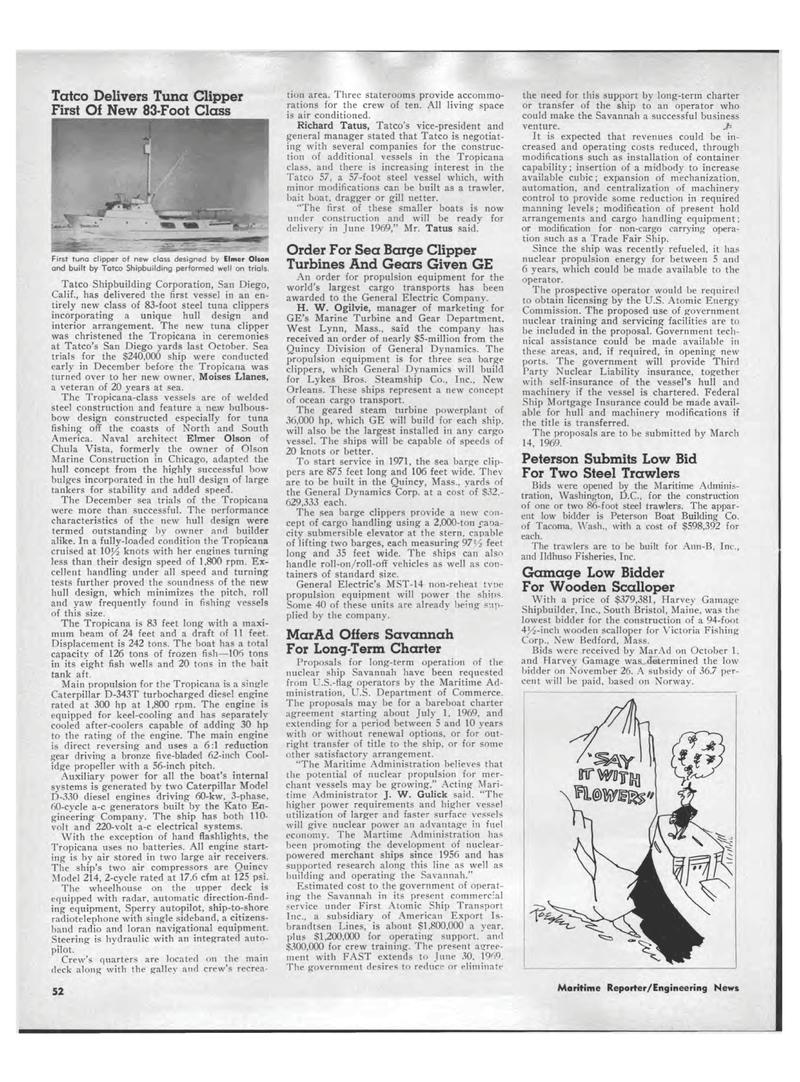
Page 50: of Maritime Reporter Magazine (January 15, 1969)
Read this page in Pdf, Flash or Html5 edition of January 15, 1969 Maritime Reporter Magazine
Tatco Delivers Tuna Clipper First Of New 83-Foot Class Tatco Shipbuilding Corporation, San Diego, Calif., has delivered the first vessel in an en-tirely new class of 83-foot steel tuna clippers incorporating a unique hull design and interior arrangement. The new tuna clipper was christened the Tropicana in ceremonies at Tatco's San Diego yards last October. Sea trials for the $240,000 ship were conducted early in December before the Tropicana was turned over to her new owner, Moises Llanes, a veteran of 20 years at sea. The Tropicana-class vessels are of welded steel construction and feature a ne.w bulbous-bow design constructed especially for tuna fishing off the coasts of North and South America. Naval architect Elmer Olson of Chula Vista, formerly the owner of Olson Marine Construction in Chicago, adapted the hull concept from the highly successful bow bulges incorporated in the hull design of large tankers for stability and added speed. The December sea trials of the Tropicana were more than successful. The performance characteristics of the new hull design were termed outstanding by owner and builder alike. In a fully-loaded condition the Tropicana cruised at 10j/£ knots with her engines turning less than their design speed of 1,800 rpm. Ex-cellent handling under all speed and turning tests further proved the soundness of the new hull design, which minimizes the pitch, roll and yaw frequently found in fishing vessels of this size. The Tropicana is 83 feet long with a maxi-mum beam of 24 feet and a draft of 11 feet. Displacement is 242 tons. The boat has a total capacity of 126 tons of frozen fish?106 tons in its eight fish wells and 20 tons in the bait tank aft. Main propulsion for the Tropicana is a single Caterpillar D-343T turbocharged diesel engine rated at 300 hp at 1,800 rpm. The engine is equipped for keel-cooling and has separately cooled after-coolers capable of adding 30 hp to the rating of the engine. The main engine is direct reversing and uses a 6:1 reduction gear driving a bronze five-bladed 62-inch Cool-idge propeller with a 56-inch pitch. Auxiliary power for all the boat's internal systems is generated by two Caterpillar Model D-330 diesel engines driving 60-kw, 3-phase, 60-cycle a-c generators built by the Kato En-gineering Company. The ship has both 110-volt and 220-volt a-c electrical systems. With the exception of hand flashlights, the Tropicana uses no batteries. All engine start-ing is by air stored in two large air receivers. The ship's two air compressors are Quincv Model 214, 2-cycle rated at 17.6 cfm at 125 psi. The wheelhouse on the upper deck is equipped with radar, automatic direction-find-ing equipment, Sperry autopilot, ship-to-shore radiotelephone with single sideband, a citizens-band radio and loran navigational equipment. Steering is hydraulic with an integrated auto-pilot. Crew's quarters are located on the main deck along with the galley and crew's recrea-tion area. Three staterooms provide accommo-rations for the crew of ten. All living space is air conditioned. Richard Tatus, Tatco's vice-president and general manager stated that Tatco is negotiat-ing with several companies for the construc-tion of additional vessels in the Tropicana class, and there is increasing interest in the Tatco 57, a 57-foot steel vessel which, with minor modifications can be built as a trawler, bait boat, dragger or gill netter. "The first of these smaller boats is now under construction and will be ready for delivery in June 1969," Mr. Tatus said. Order For Sea Barge Clipper Turbines And Gears Given GE An order for propulsion equipment for the world's largest cargo transports has been awarded to the General Electric Company. H. W. Ogilvie, manager of marketing for GE's Marine Turbine and Gear Department, West Lynn, Mass., said the company has received an order of nearly $5-million from the Quincy Division of General Dynamics. The propulsion equipment is for three sea barge clippers, which General Dynamics will build for Lykes Bros. Steamship Co., Inc., New Orleans. These ships represent a new concept of ocean cargo transport. The geared steam turbine powerplant of 36,000 hp. which GE will build for each ship, will also be the largest installed in any cargo vessel. The ships will be capable of speeds of 20 knots or better. To start service in 1971, the sea barge clip-pers are 875 feet long and 106 feet wide. Thev are to be built in the Quincy, Mass., yards of the General Dynamics Corp. at a cost of $32,-629,333 each. The sea barge clippers provide a new con-cept of cargo handling using a 2,000-ton caoa-city submersible elevator at the stern, capable of lifting two barges, each measuring 97I/2 feet long and 35 feet wide. The ships can also handle roll-on/roll-off vehicles as well as con-tainers of standard size. General Electric's MST-14 non-reheat tvoe propulsion equipment will power the ships. Some 40 of these units are already being sup-plied by the company. MarAd Offers Savannah For Long-Term Charter Proposals for long-term operation of the nuclear ship Savannah have been requested from U.S.-flag operators by the Maritime Ad-ministration, U.S. Department of Commerce. The proposals may be for a bareboat charter agreement starting about July 1, 1969, and extending for a period between 5 and 10 years with or without renewal options, or for out-right transfer of title to the ship, or for some other satisfactory arrangement. "The Maritime Administration believes that the potential of nuclear propulsion for mer-chant vessels may be growing," Acting Mari-time Administrator J. W. Gulick said. "The higher power requirements and higher vessel utilization of larger and faster surface vessels will give nuclear power an advantage in fuel economy. The Martime Administration has been promoting the development of nuclear-powered merchant ships since 1956 and has supported research along this line as well as building and operating the Savannah." Estimated cost to the government of operat-ing the Savannah in its present commercial service under First Atomic Ship Transport Inc., a subsidiary of American Export Is-brandtsen Lines, is about $1,800,000 a year, plus $1,200,000 for operating support, and $300,000 for crew training. The present agree-ment with FAST extends to June 30. 1969. The government desires to reduce or eliminate the need for this support by long-term charter or transfer of the ship to an operator who could make the Savannah a successful business venture. Jt-It is expected that revenues could be in-creased and operating costs reduced, through modifications such as installation of container capability; insertion of a midbody to increase available cubic; expansion of mechanization, automation, and centralization of machinery control to provide some reduction in required manning levels; modification of present hold arrangements and cargo handling equipment; or modification for non-cargo carrying opera-tion such as a Trade Fair Ship. Since the ship was recently refueled, it has nuclear propulsion energy for between 5 and 6 years, which could be made available to the operator. The prospective operator would be required to obtain licensing by the U.S. Atomic Energy Commission. The proposed use of government nuclear training and servicing facilities are to be included in the proposal. Government tech-nical assistance could be made available in these areas, and, if required, in opening new ports. The government will provide Third Party Nuclear Liability insurance, together with self-insurance of the vessel's hull and machinery if the vessel is chartered. Federal Ship Mortgage Insurance could be made avail-able for hull and machinery modifications if the title is transferred. The proposals are to be submitted by March 14, 1969. Peterson Submits Low Bid For Two Steel Trawlers Bids were opened by the Maritime Adminis-tration, Washington, D.C., for the construction of one or two 86-foot steel trawlers. The appar-ent low bidder is Peterson Boat Building Co. of Tacoma. Wash., with a cost of $598,392 for each. The trawlers are to be built for Ann-B, Inc., and Ildhuso Fisheries, Inc. Gamage Low Bidder For Wooden Scalloper With a price of $379,381, Harvey Gamage Shipbuilder, Inc., South Bristol, Maine, was the lowest bidder for the construction of a 94-foot 4j-2-inch wooden scalloper for Victoria Fishing Corp., New Bedford, Mass. Bids were received by MarAd on October 1, and Harvey Gamage was..determined the low bidder on November 26. A subsidy of 36.7 per-cent will be paid, based on Norway. First tuna clipper of new class designed by Elmer Olson and built by Tatco Shipbuilding performed well on trials. 52 Maritime Reporter/Engineering News

 49
49

 51
51
